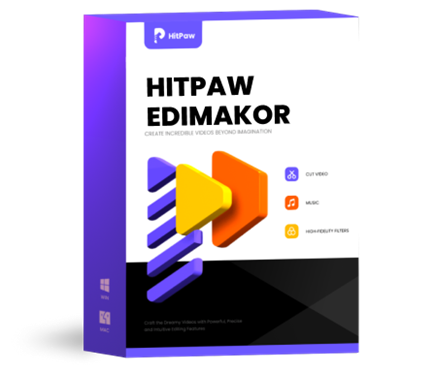Detect a Fake Social Media Profile With These 11 Tips
Some social media profiles look real until you notice something odd. Spotting one isn't always easy, especially when fake accounts copy real people or brands. This guide breaks down how to detect a fake social media profile by checking the signs that usually give it away. When you understand what to watch out for, you won't get fooled by a well-polished fake.
Create Now!Part 1. How to Detect a Fake Social Media Profile: 14 Quick Ways
A little attention to detail usually reveals what's going on. Fake social media profile accounts follow the same patterns, and once you learn what those are, it gets easier to call them out. Let's go over different ways you can check a profile to see if it's the real deal or just someone faking it.
1. Check the Profile Photo Carefully
One of the easiest giveaways sits right at the top. If the profile photo looks too perfect, chances are it's taken from somewhere else. Most fake profiles use stock images for their profile picture, stolen headshots, or AI-generated faces. The eyes sometimes look off, or the background seems oddly clean.

Try running the image through a reverse image search like Google Images or TinEye. If that same photo shows up on unrelated websites, the account's probably fake. Also, real people usually post different photos of themselves. If the profile has just one photo across all posts, that's a red flag right there.
2. Check the Account Creation Date
Real users usually have social profiles that go back years. If the account shows up as brand new, created just a few days or weeks ago, that's a warning sign. These fake profiles are rushed into creation so they can jump into activity fast. You'll notice that these accounts post quickly, comment aggressively, or start spreading opinions right after being created. That kind of behavior points to someone trying to fake influence or stir things up under a false name.
3. Look at the Username and Handle
The name might look normal at first glance, but fake social media profiles often slip in random numbers or strange spellings. You'll see names like "sarah_19978632" or "m1chael.j0hns" that don't match typical naming habits.

Scammers do this because the name they really want is already taken by the original person. If the handle doesn't match the display name or looks rushed and unprofessional, that's your clue. Real users tend to choose consistent, easy-to-remember usernames, especially if they've been active for a while.
4. Scan Through the Bio and About Section

A real social media profile usually has something personal in the bio. It could be a job title, a location, a favorite quote, or even a silly emoji chain. Fake ones often leave the bio empty or write generic lines like "Love to connect" or "Here for good vibes." Some even copy bios from other users.
It doesn't mean every private account is fake, but fake profiles use this to stay under the radar. No photos, no real name, and no backstory means there's nothing to verify, which fake users rely on.
You also need to watch for signs of mismatched info, too. If the name says someone's based in California but the bio mentions working in Dubai, that's suspicious. These small inconsistencies often expose fake profiles that didn't do their homework.
5. Review the Follower and Following Ratio
This one gives away a lot if you check closely. Most fake accounts follow hundreds or thousands of users but have very few followers themselves. You'll see ratios like 1,200 following and only 25 followers. That's not normal unless someone just joined.
On the flip side, some bots buy fake followers, which show up as blank profiles with no posts. If you check their followers and it's mostly empty accounts, that's a problem. A real profile builds a network naturally-friends, coworkers, classmates. Bots and fake users just connect to similar fakes, creating a closed loop. Also, their replies usually go unnoticed, with no one tagging them back or having a conversation. It all feels one-sided and robotic.
6. Check Post History and Content Consistency
Any fake social media profile rarely bothers to be consistent. There would be posts copied from other profiles, mixed topics with no theme, or random images that don't add up. Some have no posts at all, or they post once and disappear. If someone claims to be a travel blogger but only posts one beach photo from 2019, it doesn't hold up. Also, check if the captions match the type of content. A profile with selfies but captions that talk about crypto investing might be pretending to be someone they're not.
7. Watch How the Account Interacts with Others
Real social media users interact with friends, reply to comments, tag people, and share stories. Fake profiles usually post comments like "Nice pic!" or "DM me" across random accounts.
There's no depth to the interactions, and it feels robotic. If you go through their tagged posts and nobody seems to be interacting with them directly, it's probably not a genuine profile. Bots and scammers often skip real engagement and just spam for attention.
8. Watch for Repeated or Predictable Activity
Bots and fake social media accounts follow patterns that feel mechanical. You might notice they only post at certain times, repeat the same types of replies, or talk about the same topic-politics, finance, celebrity gossip-over and over. They might copy phrases, use similar hashtags, or comment on the same line across different posts.

Some of them stay quiet for months, then suddenly post dozens of times a day. That's not normal behavior for a regular user. Consistent activity that lacks any real engagement or variation gives away that the account isn't being run like a real person would run it. They're there to drive one message and move on. That pattern gives away that the account has a script behind it.
9. Spam and Promotional Noise
When the social media profiles keep dropping links, hashtags, or sales pitches in every post, that's another red flag. They usually promote some service, giveaway, or suspicious-looking product. They spam the same comment even on totally unrelated pages. For example, on a post that is about a sports event, you'll see a comment about a hair product.
Real users might share a link now and then, but fake profiles don't even pretend to be subtle. They drop the same thing on every post, hoping someone clicks.
10. Lack of Real Conversations
You can tell a lot by looking at the replies and comment threads. If the social profile only likes, retweets, or drops one-line comments, they're not doing what regular users do. You don't see them tag friends, joke around, or jump into a real back-and-forth. Fake profiles don't know how to act casually. They avoid any conversation where they might get exposed, and it shows in how empty their interactions feel.
11. Posts That Push Reactions Too Hard
Some fake profiles don't just blend in-they try to stir people up. You'll see extreme opinions, strong emotional claims, or constant negativity aimed at one side. These accounts aren't just weird, they're crafted to provoke. When someone posts only rage-bait or feel-good spam, with no personal insight, it's a signal that the account's real job is to push people's buttons and shift conversations.
Part 2. How to Protect Yourself from a Fake Social Media Profile
Once you know how these fake profiles operate, it gets easier to avoid falling into their trap.
Don't rush to accept requests just because a profile looks presentable. A quick look at their posts, mutual friends, or even the way they write their bio can help you figure out their authenticity. If someone you don't know starts messaging you right after following, especially with vague compliments or generic talk, there's no reason to keep the conversation going.
Below are a few things that help you stay safe when you come across a profile that raises suspicion:
- Always check their profile activity before accepting a request. If the posts look random, copied, or barely exist, it's better to let that request sit unanswered.
- Look at how they interact with others. A profile that comments the same thing under every post or never gets replies often shows signs of being fake.
- Never share sensitive personal information. You should never hand out your phone number, address, ID photos, or anything personal just because someone online sounds nice. That's exactly what scammers use to build trust before misusing your details.
- Be careful with links sent through messages. If someone you barely know sends you a link saying, "Check this out," don't open it. Most of the time, that leads to phishing or scam pages.
- Don't rely only on how the profile looks. Some fake accounts use attractive pictures and well-written bios just to come across as normal. Always take a few extra seconds to examine the details before engaging.
- Use the block and report buttons when needed. If something feels off or someone starts acting pushy or suspicious, it's okay to remove them. You don't owe anyone your time or trust on social media.
These small habits keep your account and personal space safer. Fake social media profiles expect people to skip over the warning signs, so paying attention puts you a step ahead.
Part 3. FAQs of Fake Social Media Profile
Q1. Is it possible to trace a fake social media account?
A1. Yes, law enforcement can trace a fake social media account if it's tied to illegal activity. They can request data directly from the platform using a subpoena or search warrant as part of an official investigation. This usually happens when serious violations are involved.
Q2. How can you tell a fake profile?
A2. A fake social media profile usually slips up in the details. You might see a blank bio, mismatched photos, a strange username, or posts that don't add up. If they follow thousands but barely get any interaction, or they only post generic comments, that's a strong sign that something isn't real.
Q3. What is it called when people make fake accounts on social media?
A3. It's called online impersonation. That's when someone creates a fake account pretending to be another person, group, or business. It shows up across social media, dating apps, and even gaming sites, often to mislead others or take advantage of someone's identity.
Q4. Is it worth having a fake social media account?
A4. No, it's not. Fake accounts might seem harmless at first, but they often cross into risky territory. People use them to spread hate, bully others, or even coordinate illegal activities. In serious cases, law enforcement can step in and trace the account through the platform.
Conclusion on Fake Social Media Profile
In this guide, you learned about how to detect a fake social media profile using different tips and tricks to safeguard your privacy. You've seen how profile photos, usernames, post patterns, and even follower lists can reveal what someone's really up to. Paying attention to these details doesn't just protect your account-it keeps your personal space clean from scams and impersonators.
If you ever want to check whether a profile picture is fake or AI-generated, you can also use HitPaw AI Image Detector. It's a quick way to figure out if someone's using a fabricated face on their account to help you confirm what your instincts already suspect.








Home > Learn > Detect a Fake Social Media Profile With These 11 Tips
Select the product rating:
Natalie Carter
Editor-in-Chief
My goal is to make technology feel less intimidating and more empowering. I believe digital creativity should be accessible to everyone, and I'm passionate about turning complex tools into clear, actionable guidance.
View all ArticlesLeave a Comment
Create your review for HitPaw articles